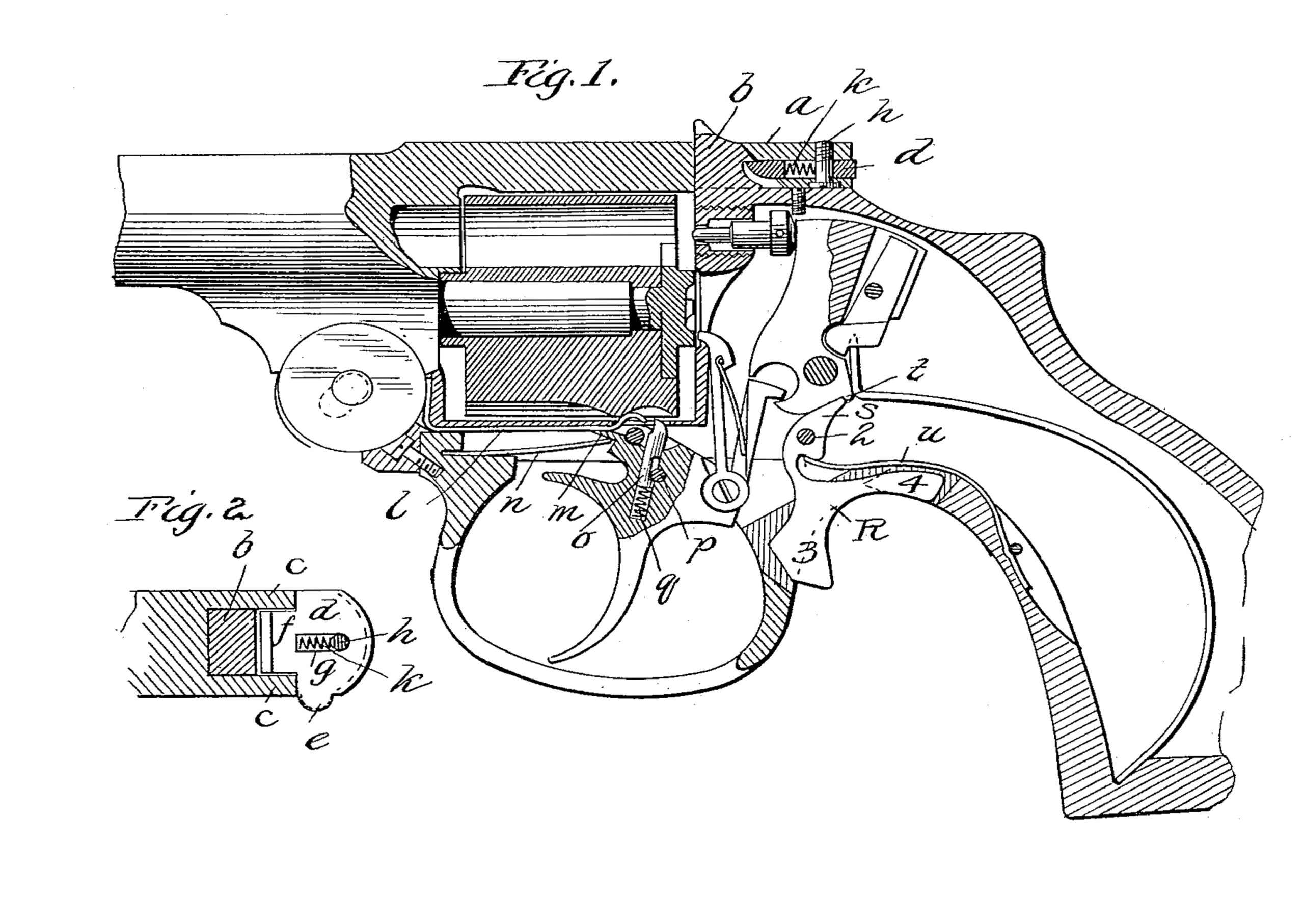US 471112
UNITED STATES PATENT OFFICE.
CHARLES FOEHL AND CHARLES A. WEEKS, OF PHILADELPHIA, PENNSYLVANIA
BARREL-STRAP CATCH FOR REVOLVERS.
SPECIFICATION forming part of Letters Patent No. 471,112, dated March 22, 1892.
Application filed February 28, 1891. Serial No. 383,220. (No model.)
To all whom it may concern:
Be it known that we, CHARLES FOEHL and CHARLES A. WEEKS, citizens of the United States of America, residing at Philadelphia, in the county of Philadelphia and State of Pennsylvania, have invented certain new and useful Improvements in Fire-Arms, of which the following is a specification.
Our invention is an improvement upon firearms of that class in which the revolving cylinder provided with a series of chambers is mounted upon a barrel.
The improvements are shown as embodied in a pistol, the general form of which is shown in a patent of Foehl, granted by the United States Patent Office on the 17th day of December, 1889, No. 417,672.
Our invention is illustrated in the accompanying drawings, in which—
Figure 1 shows the working parts in side elevation and partly in section, the sectional plane being substantially the central vertical one through the pistol. Fig. 2 is a plan view in detail of the lock of the barrel-strap, the strap being in horizontal section.
In the catches or locks which secure the barrel-strap to the post of the frame it is desirable to provide full bearing for the surfaces of the post and catch, which are in contact, with a minimum amount of movement of the catch and at the same time to secure simplicity of construction and the least possible number of parts. With these objects in view we have, in connection with the strap a and the post b of the ordinary construction, provided in the rear end of the strap a simple transverse slot, which may be cut horizontally in the end of the strap from side to side a sufficient distance to allow the extension for the thumb-piece and movement of the catch. Beyond this the slot extends in a form of mortise into the strap, leaving the walls c c on each side the mortise extending forward to and opening into that which receives the post of the frame. The catch d is a plain piece of metal fitted to the plain slot, having its rear edge preferably rounded, with the thumb-piece e on the left-hand side projecting beyond the strap and with a lip f extending through the mortise to the lip of the post. The catch is provided with a slot g, through which is inserted a screw h from the under side, which secures the catch in place. Between the screw and the forward end of the slot is inserted a spring k, which presses the catch forward. The catch and the lip on the post are beveled, as shown, for automatic engagement.
From this construction it will be apparent that the catch slides bodily and in right lines toward and from the post and bears equally upon the lip of the post when engaged therewith and when disengaged frees itself from contact by its rearward movement equally on both sides. It therefore requires a less amount of movement than it would require if pivoted upon one side and one pin or screw serves to hold it in place and to limit its movement.
We have shown other points of novelty in connection with our improved barrel-strap catch, and make no claim to these features in the present application, as they are the subject of pending applications.
We claim as our invention—
In combination with the frame of a pistol and with the post b, having the notch on its rear face, a strap having an opening to admit the post, and a transverse slot in its rear end extending from side to side and opening to the rear, and a mortise extending from said slot to the post-opening, and a catch d, having a thumb-piece e extending laterally beyond the strap and a central projecting tongue to engage with the notch in the post, said tongue bearing on the inner walls of the mortise to be guided thereby, the catch being provided with a vertical slot formed centrally in its body portion, a pin set in the strap, extending through the slot in the catch, and a spring bearing at one end against the wall of the slot, whereby the catch will be held yieldingly in place and will be properly guided when pressed upon at one side, substantially as described.
In testimony whereof we affix our signatures in presence of two witnesses.
CHARLES FOEHL,
CHAS. A. WEEKS.
Witnesses:
Rost. M. FRANKS,
F. L. MIDDLETON.

